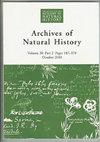Nature on the airwaves: natural history and the BBC in interwar Britain, 1922–1939 (William T. Stearn Student Essay Prize 2021)
IF 0.3
4区 哲学
Q3 HISTORY & PHILOSOPHY OF SCIENCE
引用次数: 0
Abstract
Archival and other historical evidence, including digitized issues of The Radio Times and files from the British Broadcasting Corporation’s Written Archives Centre, reveal the pivotal importance that natural history played in the BBC’s programming during the 1920s and 1930s. Beyond merely replicating the forms and styles that could be found across other forms of mass media, natural history broadcasts demonstrated to the British public what radio technology was capable of. At the same time, radio was not isolated from the media landscape of the period, and natural history broadcasts made full use of visual accompaniments such as magazines and pamphlets. Examining a variety of different broadcasts, this paper focuses on how expertise was fashioned behind the microphone, on “stunts” such as broadcasting the live sounds of animals, on audience participation, and on broadcasts aimed at young audiences. Broadcast lessons for schools, which are generally overlooked by historians, offer a rich opportunity for examining how natural history radio developed over the years. Children’s hour characters like the “Zoo Man” modelled an intimate, direct way of engaging with young audiences. Moreover, experiments in field ecology involving listeners in the collection of data showed that radio could act as a two-way medium. These broadcasts helped to shape the modern phenomenon of the nature documentary that would take off after 1945. While the origins of this phenomenon are usually traced either to the establishment of the BBC’s Natural History Unit in 1957, or in some cases to early nature films, there is a strong case for considering the BBC’s interwar broadcasts (1922–1939) as part of this trajectory.《电波中的自然:1922-1939年两次世界大战之间英国的自然历史和BBC》(威廉·t·斯登学生论文奖2021)
档案和其他历史证据,包括数字化的《广播时报》和英国广播公司书面档案中心的文件,揭示了20世纪20年代和30年代自然历史在BBC节目中发挥的关键作用。除了复制在其他形式的大众媒体中可以找到的形式和风格之外,自然历史广播向英国公众展示了无线电技术的能力。与此同时,广播并没有脱离当时的媒体格局,自然历史广播充分利用了杂志和小册子等视觉伴奏。本文考察了各种不同的广播,重点关注麦克风背后的专业知识是如何形成的,“特技”,如直播动物的声音,观众的参与,以及针对年轻观众的广播。学校的广播课通常被历史学家所忽视,为研究自然历史广播多年来的发展提供了丰富的机会。像“动物园人”这样的儿童时刻角色以一种亲密、直接的方式与年轻观众互动。此外,在野外生态学中,听众参与数据收集的实验表明,无线电可以作为一种双向媒介。这些广播节目帮助塑造了1945年后兴起的现代自然纪录片现象。虽然这一现象的起源通常可以追溯到1957年BBC自然历史部门的成立,或者在某些情况下追溯到早期的自然电影,但有一个有力的理由可以认为BBC在两次世界大战之间的广播(1922-1939)是这一轨迹的一部分。
本文章由计算机程序翻译,如有差异,请以英文原文为准。
求助全文
约1分钟内获得全文
求助全文
来源期刊

Archives of Natural History
HISTORY & PHILOSOPHY OF SCIENCE-
CiteScore
0.40
自引率
50.00%
发文量
34
审稿时长
>12 weeks
期刊介绍:
Archives of Natural History (formerly the Journal of the Society for the Bibliography of Natural History) publishes peer-reviewed papers on the history and bibliography of natural history in its broadest sense, and in all periods and all cultures. This is taken to include botany, general biology, geology, palaeontology and zoology, the lives of naturalists, their publications, correspondence and collections, and the institutions and societies to which they belong. Bibliographical papers concerned with the study of rare books, manuscripts and illustrative material, and analytical and enumerative bibliographies are also published.
 求助内容:
求助内容: 应助结果提醒方式:
应助结果提醒方式:


